HPE6-A45 Online Practice Questions and Answers
Refer to the exhibit.
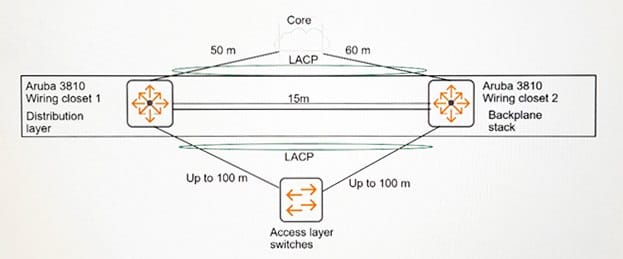
A company requires distribution layer switches that can provide Layer 2 and Layer 3 redundancy. The exhibit shows the proposal for these switches.
Which change to the proposal will help meet the company's requirements?
A. The proposed switches should be replaced with switches such as the Aruba 2930M to support the backplane stacking technology.
B. VRRP should be implemented instead of backplane stacking to support the Layer 3 redundancy requirements.
C. Link aggregations should be established without LACP to support the Layer 2 redundancy requirements and backplane stacking limitations.
D. The proposed switches should be replaced with switches that support VSF to support the required distance between stack members.
An AOS-Switch enforces 802.1X. It receives an Access-Accept with this HPE VSA from its Radius server: Attribute Name and ID = HPE-User-Role (25) Value = contractor
The switch then rejects the client. What is one requirement for the switch to accept the message and authorize the client?
A. The initial user role must be set to the factory default permit any role.
B. User role authorization must be enabled globally on the switch.
C. An aaa authentication local user group must have the contractor name.
D. The RADIUS server settings must permit dynamic authorization.
Refer to the exhibits. Exhibit 1
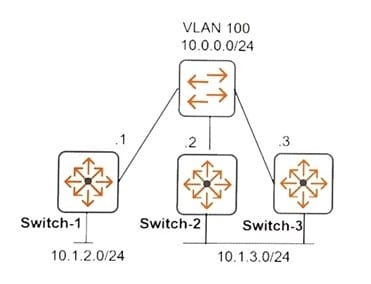
Exhibit 2

Exhibit 1 shows the topology for the network. The network administrator sees the log entries shown in Exhibit 2. Which type of failure is indicated?
A. A link between Switch-1 and Switch-2 went down. BFD detected the lost connectivity and behaved as expected.
B. Graceful restart helper was not enabled on Switvh-2, so BFD was unable to operate correctly, and the session was taken down.
C. A hardware issue caused a unidirectional link; BFD detected the issue at Layer 2 and prevented a broadcast storm.
D. BFD was set up incorrectly on Switch-2, so it caused Switch-2 to lose adjacency with Switch-1 rather than repair the session.
Refer to the exhibits. Exhibit 1
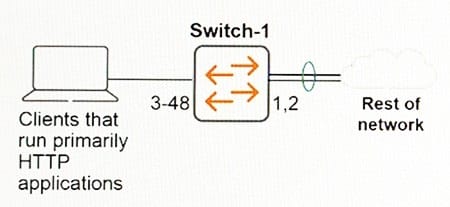
Exhibit 2 Network administrators are alerted to high interface utilization on a switch by a management solution. They examine the utilization on the uplink interfaces several times an hour during problem times. The exhibit shows output typical of times of congestion. The administrators want to allocate bandwidth fairly and reduce congestion on the uplinks.
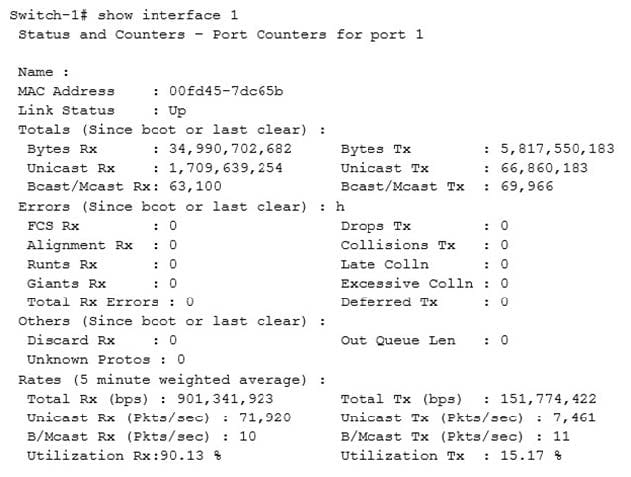
What could help meet these requirements?
A. a per-queue rate limit on interfaces 1 and 2
B. an outbound rate limit on each edge port
C. a broadcast rate limit on each edge port
D. an outbound rate limit on interfaces 1 and 2
Refer to the exhibit.

An AOS-Switch has the ACL shown in the exhibit. A network administrator then enters these commands: Switch(config)# mac-access-list standard myACL Switch(config-std-macl)# deny 007d.45cc.0000 0000.0000.ffff
How does this ACL treat these frames: 1 = 007d.45cc.ffff 2 = 007d.45cc.0000
A. It denies both frames.
B. It permits both frames.
C. It denies frame 1 and permits frame 2.
D. It permits frame 1 and denies frame 2.
Refer to the exhibit.
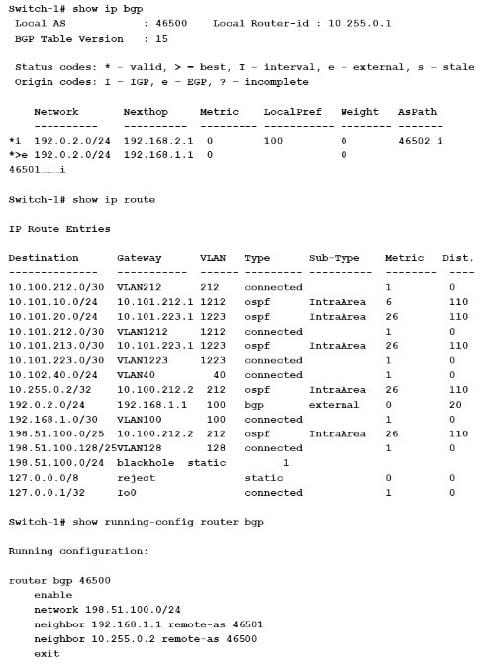
Switch-1 is routing traffic to 192.0.2.0/24 over a less-than-optimal path.
Which issue could prevent Switch-1 from selecting the first route listed in the table as a best BGP route?
A. It does not have AS 46501 configured on it.
B. It has no route to 192.168.2.1 in its IP routing table.
C. It has no network statement for 192.168.2.0/24 in its BGP configuration.
D. It has learned the same route using OSPF.
Refer to the exhibit.

An administrator created a backplane stack with the plug-and-play method, and did not alter the default backplane stacking settings. Later, two backplane stacking links failed, as shown in the exhibit.
What happens to the backplane stack after the failures?
A. The standby becomes the commander of its fragment, which remains active. The fragment with the commander becomes inactive.
B. The fragment that contains the commander operates at Layer 2 and layer 3, and the other fragment operates at layer 2 only.
C. The fragment that contains the commander remains active, and the fragment with the standby member is disabled.
D. The standby becomes the commander of its fragment. Both fragments remain active and operate at both Layer 2 and Layer 3.
AOS-Switch runs IGMP in data-driven mode. What behavior does it exhibit?
A. It drops multicasts destined to groups that have no members
B. It preempts the querier role even if another device has higher priority
C. It floods multicasts on all ports in the VLAN if the group has at least one member
D. It disables automatic fast leave on ports that connect to a single device
A network administrator needs to find the source of a performance issue. The administrator has seen that interfaces sometimes start to drop many packets, but the issue is intermittent, and the administrator is not sure exactly when it happens. The administrator wants to be alerted when interfaces start to drop packets. The switches already have an SNMP trap server configured on them.
What else should an administrator do on these switches?
A. Enable link change SNMP traps on the switch
B. Set up RMON alarms on dropped packet statistics
C. Set the trap server to inform mode
D. Enable debugging to the session
Refer to the exhibit.
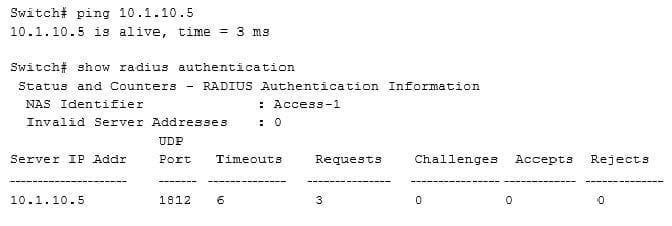
A network administrator sets up 802.1X authentication to a RADIUS server on an AOS-Switch. The RADIUS server and user devices are both set up to use PEAP MSCHAPv2. The administrator tests the authentication and sees the output shown in the exhibit.
Which issue could cause this output?
A. The administrator entered the wrong password for the test account
B. The RADIUS shared secret does not match on the switch and the server
C. The switch does not have a certificate for port-access installed on the switch
D. The switch port is set for user mode 802.1X, but the RADIUS server is set for port mode
A company has a mixed wireless and wired Aruba solution. It wants to encrypt messages used to send configurations and other important messages to the APs carried outside the GRE tunnels. What can the company do to meet these goals?
A. Deploy Aruba Meridian and integrate the AOS-Switches with it.
B. Configure extended IP ACLs on the AOS-Switches to filter the traffic.
C. Use PAPI enhanced security.
D. Use tunneled node to send traffic through an Aruba Mobility Controller.
What is a reason to implement PIM-DM as opposed to PIM-SM?
A. to conserve bandwidth over WAN links
B. to permit a higher density of rendevous point (RP) routers in the network core
C. to control exactly which multicast groups are routed through the network
D. to obtain the simplest setup in a network with high bandwidth
Refer to the exhibits.
Exhibit 1
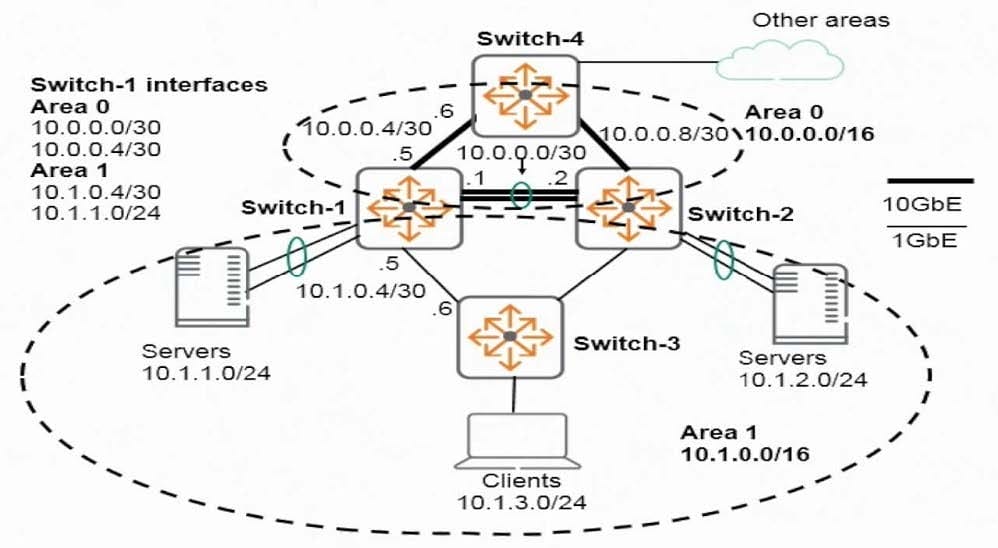
Exhibit 2
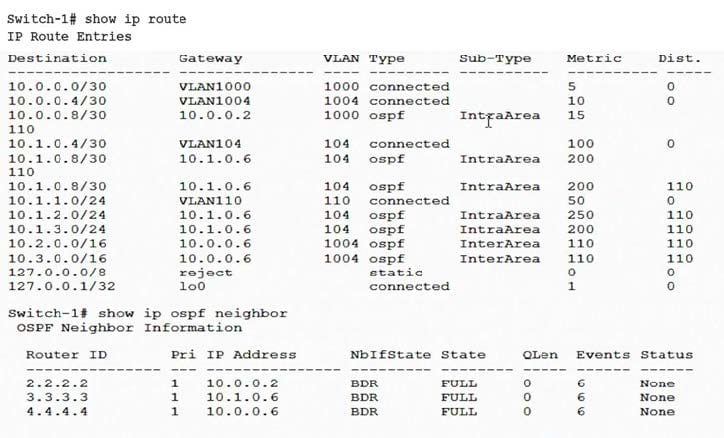
Traffic between servers in Area 1 takes a sub-optimal path rather than the link dedicated to VLAN 1000, subnet 10.0.0.0/30. Based on the exhibits, what can administrators do to create a better path for this traffic?
A. Decrease the OSPF cost on the VLAN 1000 interface on Switch-1 and Switch-2.
B. Add a virtual OSPF link between Switch-1 and Switch-2.
C. Add a VLAN in OSPF Area 1 on the link between Switch-1 and Switch-2.
D. Make sure that OSPF is enabled in Area 0 on VLAN 1000 on both Switch-1 and Switch-2.
OSPF Area 1 has two ABRs. One ABR is configured with this range for Area 1: 10.10.0.0/16. The other ABR is configured with this range for Area 1: 10.10.0.0/17.
Which type of issue occurs due to this mismatch?
A. The ABRs lose adjacency entirely and cannot route traffic between each other at all.
B. The ABRs create a discontiguous area and disrupt intra-area routing between devices within Area 1.
C. The ABRs advertise routes inconsistently, and they could potentially introduce a routing loop.
D. The ABRs lose adjacency in Area 1 and must route all traffic to each other through Area 0.
What is a typical reason to implement MAC authentication on an AOS-Switch?
A. to filter traffic at the edge, based on multiple criteria in the MAC header
B. to provision switch ports to support devices such as IP phones or printers
C. to enhance the security of an 802.1X solution
D. to control management access to the switch CLI based on device, as well as user credentials
